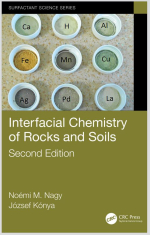Добрый день, Коллеги. Важное сообщение, просьба принять участие. Музей Ферсмана ищет помощь для реставрационных работ в помещении. Подробности по ссылке
Interfacial chemistry of rocks and soils / Межфазная химия горных пород и почв
The crust of the Earth is made up of rocks and soils, the latter produced by the weathering of rocks. Therefore, rocks and soils contain the same chemical elements, and their mineral composition is also similar. In addition, soils contain organic matter.
Rocks are defined as incoherent, naturally formed substances, mostly composed of minerals. They can be classified as igneous, sedimentary, and metamorphic, depending on their origin. Rocks are stable in the conditions under which they were formed. When environmental conditions are changed, they become thermodynamically unstable. This happens on the surface of the Earth when the rocks interact with the atmosphere, hydrosphere, and biosphere. The formation of soils is the result of the interactions between the rocks and the atmosphere, hydrosphere, or biosphere. The mineral transformations, including weathering, have been extensively studied and described as interactions of the lithosphere, hydrosphere, atmosphere, and biosphere (Kabata-Pendias and Pendias 1985, p.15). These processes are not limited to the solid phase; the liquid phase is also involved and plays an important role. As in all chemical processes, these interactions are driven toward achieving a chemical equilibrium, that is, the species formed must be thermodynamically more stable under the particular conditions than the original material was.
The same can be said for any substances getting onto the rocks and soils regardless of its source (e.g., anthropogenic or other), which tend to transform if they are thermodynamically unstable. Obviously, the environment is not a closed system; therefore, the laws of thermodynamics will only determine the direction of the processes but not their final results. Furthermore, kinetic barriers also limit achievement of the equilibrium. The soil is an intermediate stage of this thermodynamically driven process during which rocks transform into other stable species under changed conditions <...>




